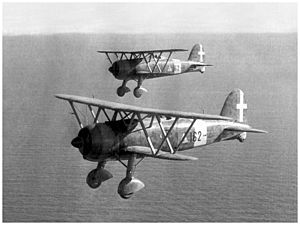| CR.42 Falco | |
|---|---|
 Two CR.42's of 162a Squadriglia, 161° "Autonomous Terrestrial Fighter Group", Aegean Islands 1940 | |
| General information | |
| Type | Fighter |
| National origin | Italy |
| Manufacturer | Fiat Aviazione |
| Status | Out of service |
| Primary users | Regia Aeronautica |
| Number built | 1,817–1,819[1][2][3] |
| History | |
| Manufactured | c. February 1939 – late 1943 |
| Introduction date | 1939 |
| First flight | 23 May 1938 |
| Retired | 1948 Spanish Air Force[4] |
| Developed from | Fiat CR.32 |
The Fiat CR.42 Falco (Falcon, plural: Falchi) is a single-seat sesquiplane fighter developed and produced by Italian aircraft manufacturer Fiat Aviazione. It served primarily in the Italian Regia Aeronautica in the 1930s and during the Second World War.
The CR.42 was an evolution of Fiat’s earlier CR.32 fighter, featuring a more powerful supercharged Fiat A.74R1C.38 air-cooled radial engine and aerodynamic improvements to its relatively clean exterior surfaces. The aircraft proved to be relatively agile in flight, a factor that had been attributed to its very low wing loading and a sometimes decisive tactical advantage. RAF Intelligence praised its exceptional manoeuvrability, further noting that "the plane was immensely strong",[5] though it was technically outclassed by faster, more heavily armed monoplanes.[6] While primarily used as a fighter, various other roles were adopted for some variants of the type, such as the CR.42CN night-fighter model, the CR.42AS ground-attack aircraft, and the CR.42B Biposto twin-seat trainer aircraft.
During May 1939, the CR.42 entered service with the Regia Aeronautica; it was the last of the Fiat biplane fighters to enter front line service. By 10 June 1940, the date when Italy entered the Second World War, roughly 300 of the type had been delivered, which defended metropolitan cities, and important military installations at first. By the end of 1940, the Falco had been involved in combat on various fronts, including the Battle of France, the Battle of Britain, Malta, North Africa, and Greece. By the end of the war, Italian CR.42s had been used on further fronts, including Iraq, the Eastern Front and the Italian mainland. Following the signing of the Italian armistice with the Allies on 8 September 1943, the type was relegated to use as a trainer by the Italian Co-Belligerent Air Force, while some Italian CR.42s were seized by the Germans and used by the Luftwaffe to perform ground-attack operations.
The CR.42 was produced and entered service in smaller numbers with the air forces of other nations, including Belgium, Sweden and Hungary. By the end of production, in excess of 1,800 CR.42s had been constructed, making it the most numerous Italian aircraft to be used during the Second World War.[7] Aviation author Przemyslaw Skulski has claimed that the fighter had performed at its best during its service with the Hungarian Air Force, specifically during its deployment against Soviet forces on the Eastern Front of the war, where it reportedly achieved a kill to loss ratio of 12 to 1.[8]
- ^ Cite error: The named reference
Sgarlato 2005was invoked but never defined (see the help page). - ^ De Marchi, Italo. Fiat CR.42 Falco (in Italian). Modena, Italy: Stem Mucchi.
- ^ Munson 1960, p. 19.
- ^ "Historical Listings: Spain, (SPN) Archived 2011-07-20 at the Wayback Machine." World Air Forces. Retrieved: 19 May 2011.
- ^ Haining 2005, pp. 8, 15.
- ^ Wheeler 1992, p. 50.
- ^ Avions militaires 1919–1939 – Profils et Histoire1979, p. 89.
- ^ Skulski 2007, p. 67.